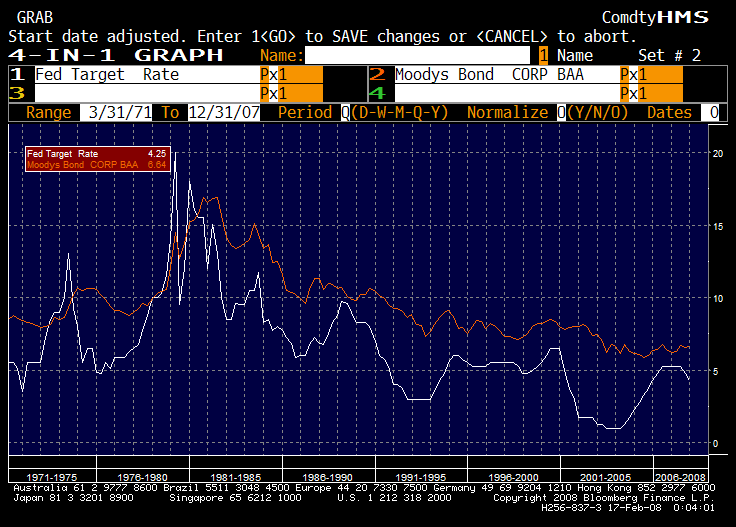Thanks to Naked Capitalism for pointing out this post by Paul Krugman. Here was my response:
Mr. Krugman, do your homework. Extend the graph out to five years, and you will see that yields on Baa bonds fluctuated between 7.1% and 5.7% over that time period. The correlation between Fed funds and Moody’s Baa series was pretty small during that time period, whether the fed funds rate was rising or falling. I just calculated the R-squared on the regression — 0.1%, for a 3.2% correlation.
Maybe it’s just a bad time period, so I ran it back to 1971, which was as far as my Bloomberg terminal would let me go. (Maybe I’ll go to FRED and download longer series, and use Excel, but I don’t think the result will be much different — the R-squared was 6.5%, for a correlation coefficient of 25.5%. Not a close relationship in my book for two time series relationships that are both interest rates.
Practical economists like me are aware that credit-sensitive investments often have little practical relationship to Fed funds. We work in the trenches of the bond market, not the isolation of academic economics, where you don’t contaminate your theories with data.
The Fed may or may not be pushing on a string, but you have certainly not proven your case.
-=-=-=-=-
Here’s the graph for the Fed funds rate and Moody’s Baa yield series since 1971. (When I ran my calculations, I used monthly, but could only get the graph back to 1971 if I went to quarterly.

(graph: Bloomberg)
As I said, not much of a correlation, but why so low?? This is related to a topic on which Bill Rempel has asked me for an article.? (To do that article, I have to drag a lot of yield data off of Bloomberg for analysis; I will be getting my full subscription soon, and once that happens, I can start.)
As an investment actuary, I’ve had to develop models of the full? maturity/credit yield curve — maturities from 3 months to 30 years (usually about 10 points) and credit from Treasuries, Agencies and Swaps to Corporates, AAA to Single-B.? A Treasury yield curve at any point in time can be fairly expressed by a four factor model, and the R-squared is usually around 99%.? (I learned this in 1991, and there is a funny story around how I learned this, involving a younger David and a Bear Stearns managing director.)
The short end of the Treasury yield curve is usually far more volatile than the long end in yield terms (but not in price terms!).? All short high-quality rates are tightly correlated, and that includes Fed funds, Agency discount notes, T-bills, LIBOR (well, usually), A-1/P-1 commercial paper, etc.? As one goes further down the yield curve in maturity, the correlations weaken, but still remain pretty tight among bonds rated single-A or better.? (As a further note, Fed funds and 30-year Treasury yields also don’t correlate well.)
Credit is its own factor, which varies with expectations of the economy’s future prospects.? A single-B, or CCC borrower can only repay with ease if the economy does well.? If prospects are looking worse, no matter what the Fed does to short high-quality rates, junk grade securities will tend to rise in yield.? Marginal investment grade securities (BBB/Baa) will tread water, and short high-quality bond yields will correlate well with Fed funds.
When I say “credit is its own factor,” what I am saying is that outside of Treasury securities, every credit instrument participates to varying degrees in exposure to the future prospects of the economy.? (Credit in its purest form behaves like equity returns.)? For conservatively capitalized enterprises with high quality balance sheets, their credit spreads don’t change much as prospects change for the economy.? For entities with low quality balance sheets, their spreads change a lot as prospects change for the economy.
So, for two reasons, Mr. Krugman should not have expected the Fed funds target rate and the Moody’s Baa yield to correlate well:
- Fed funds is a short rate, and Moody’s Baa is relatively long (bonds go over the full maturity spectrum).
- Fed funds correlates well with the highest quality yields, and Baa is only marginally investment grade.? Recessions should hurt Baa spreads, leaving yields relatively constant.

You know if Krugman contends the Fed controls the FFR then Krugman’s interest rate comparison/correlation would be just as ridiculous.
I.e., the effect of Fed operations on All other (except the discount rate) INTEREST RATES is INDIRECT, and VARIES WIDELY OVER TIME, and IN MAGNITUDE
Very nice work.
I have no opinion at this time on Krugman, but just looking at your chart, Moody’s looks akin to a slightly lagging moving average of the Federal funds rate. They do actually move in synch to that extent, and quite remarkably. The entire Fed rate looks like a dead cat bounce begging rates declining to between 2 and 3 percent within two to three years.
Just a suggestion — you might want to light up the logo at the top of your blog with a hyperlink so we can easily get to your home page.
Perhaps I can do a lagged regression. And, you’re not the first to ask for a link up top. Since I am my own programmer here, I’ll see what I can do.